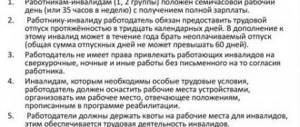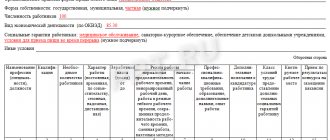Concept and criteria for determining mass layoffs
According to the provisions of Part 1 of Art. 82 of the Labor Code of the Russian Federation, the circumstances for recognizing a reduction as massive are determined by industry and territorial agreements. However, such documents are not accepted for all areas of activity and categories of enterprises.
no agreements apply to the company , then the criteria for the mass dismissal of workers are determined on the basis of subparagraph. “b” and “c” clause 1, clause 2 of the Decree of the Government of the Russian Federation dated 02/05/1993 No. 99. These include:
- withdrawal from the state of 50 or more units within 30 calendar days;
- dismissal of 200 or more people within 2 months;
- reduction of 500 employees in 3 months (90 days);
- dismissal of 1% of the company's workers within 30 calendar days, if the total number of employees in the region does not exceed 5,000 people.
IMPORTANT!
There are no special grounds for recognizing mass dismissal during the period of coronavirus infection 2021 . In this regard, you should be guided by the above criteria.
Workers' compensation and guarantees
Termination of cooperation with an employee due to downsizing or liquidation of the company gives rise to the payment of severance pay.
Even despite the greater number of dismissals, the employer must provide the required benefits to each subordinate. So, standard payments mean:
- employee income for the period worked at the company;
- compensation for unused days of annual leave;
- severance pay.
Severance pay is paid immediately for the first month from the date of dismissal ; in addition, during the second month, the employee can also receive the average salary from the employer if he was unable to find a job. If an employee quickly registers with the employment center (within two weeks from the date of dismissal), then he can also be paid for the third month of searching for a new job.
The exception applies only to residents of the Far North and equivalent territories - for them, the period for paying compensation for the duration of employment has been increased to six months (for this you also need to register with the employment center).
How does a mass layoff work?
A mass layoff is also a reduction in staff. Therefore, the procedures for carrying them out are generally similar. The only difference is that when releasing a large number of personnel within a short period of time, the trade union and the employment service must be in advance - 3 months in advance (paragraph 1, paragraph 2, article 25 of the Law of the Russian Federation of April 19, 1991 No. 1032-1).
There is currently no special form for informing the employment service. However, its regional branches may introduce their own forms. Therefore, before submitting information, you need to clarify this issue with your local employment center.
In any case, the information provided must contain the following data on the employee planned for dismissal:
- FULL NAME.;
- job title;
- information about average salary.
IMPORTANT!
For the period from 04/13/2020 to 12/31/2020, you need to post information about the proposed mass layoff on the “Work in Russia” resource (clause 4 of the Russian Government Resolution No. 486 dated 04/12/2020, clause 2 - Temporary Rules for Presenting Information on Dismissal).
To provide information, you can use a form of your own design with the necessary details or use a form approved by Decree of the Government of the Russian Federation dated 02/05/1993 No. 99:
INFORMATION FORM ABOUT MASS REDUCTION
The primary trade union organization is also notified no later than 3 months before dismissal (Part 1 of Article 82 of the Labor Code of the Russian Federation). The notification document lists the full name. and positions of employees planned for release.
TRADE UNION NOTIFICATION OF MASS TERMINATION: SAMPLE FORM
Employees should be notified at least 2 months before the date of separation - in writing, indicating the details of the layoff order.
The notice can offer the employee to terminate the employment relationship with payment of average earnings, without waiting for the end of 2 months for warning.
The notification is given to each employee against signature or made in 2 copies with the employee’s receipt stamped on the first one. If the person being laid off has grounds for preferential retention of work, the notification can ask him to provide the relevant documents.
FORM OF NOTIFICATION TO AN EMPLOYEE ABOUT TERMINATION DUE TO MASS REDUCTION
Drawing up a dismissal order
The document must be drawn up several months before the layoff, and this will be possible after changes are made to the staffing table. The order must display the following information:
- Name of the organization;
- the number of employees who are being laid off;
- the positions of the dismissed employees and the names of the departments in which they work;
- reasons for the reduction;
- date of reduction.
The order is assigned a serial number and signed by the heads of the organization. Afterwards, employees and trade union representatives must familiarize themselves with the document.
A sample document is available.
Responsibility for violation of the mass reduction procedure
The list of consequences for a company that violates the established procedure for mass layoffs is quite extensive:
- reinstatement of the employee through the court with payment of lost earnings (paragraph 1 and article 234, part 1 and article 394 of the Labor Code of the Russian Federation);
- application of administrative penalties on the basis of Part 1 and Art. 5.27 Code of Administrative Offenses of the Russian Federation (legal entities: 30,000 – 50,000 rubles ; individual entrepreneurs: 1000 – 5000 rubles );
- for late notification of the employment service - fines under Art. 19.7 of the Code of Administrative Offenses of the Russian Federation (for legal entities and individual entrepreneurs: 3000-5000 rubles , for officials: 300 – 500 rubles ).
Reasons for reduction
The ongoing economic crises in the Russian economy, errors in enterprise management strategy, and the development of new technologies are the reasons leading to a massive reduction in staff, or even its complete elimination. The main reasons include:
- bankruptcy of an enterprise;
- liquidation of the organization;
- change of company management;
- change in staffing;
- introduction of new technologies to automate production processes, etc.
Let's sum it up
If the reduction of staff planned by the employer meets the criteria for mass reduction, then the procedure for carrying it out becomes more complicated.
In addition to the personnel audit - in order to determine who cannot be dismissed due to reduction, and who should be offered available vacancies - a notification to the employment service and the trade union is also necessary.
Violation of the order threatens the employer with consequences in the form of fines, employees winning cases for reinstatement at work and payment for forced absences and moral damages.
Read also
08.04.2020
Video: What is guaranteed to an employee upon redundancy?
A few words about what payments you can count on if you are a victim of mass layoffs. Advice from a lawyer will help you not to be left without a livelihood while you look for a new job:
Mass reduction is a process in which the number of staff members at an enterprise is sharply reduced over a certain period of time. The scale of dismissal is determined depending on the time during which the reduction was carried out. Staff reduction should begin with the preparation of a dismissal procedure, which involves the selection of workers who are subject to layoffs. Next, measures are taken to notify the relevant services and employees about the decision made.
Mass phenomenon
The rate of mass dismissal depends on the length of the period of time during which the reduction occurs. A reduction in the number of employees must be distinguished from a reduction in staff. In the first case, we are talking about the release of employees who occupy the same positions, and in the second, not only positions, but also entire departments are removed from the staffing table. Massive staff reductions without liquidation are possible in cases where some parts of the organization will still continue to operate.
The law also defines categories of employees whom the employer can dismiss during layoffs, but is obliged to provide with jobs. This list includes:
- women who are pregnant and have children under 3 or 6 years of age. According to the law, until the child reaches the age of 3 years, a woman is usually on maternity leave. When a child under 6 years of age needs home care, the mother provides this care legally;
- single mothers with children under 14 years of age, as well as disabled children;
- divorced women who are raising a child on their own (even if they receive alimony from his father);
- widows;
- single fathers, guardians and adoptive parents;
- employees who have not reached the age of majority (aged 14−18 years). Here we are already talking about obtaining the consent of the children's services.
Agreement of the parties
Dismissal at one's own request can also be made by agreement of the parties. What does this mean? That the employee and employer can agree on various nuances of terminating the employment contract. For example - and this happens most often - according to the agreement, the employee will work not the mandatory two weeks, but only three days, or will be fired on the same day he submits the application.
But the agreement may include more than that. You can also agree on the nuances of transferring cases and training a new employee, additional payments in connection with dismissal, and so on.
Of course, it is recommended that such an agreement be drawn up in writing, in duplicate, and certified by the signatures of the employee and the employer, the seal of the enterprise, and, if necessary, also the signatures of witnesses. This is necessary so that the parties cannot subsequently accuse each other of non-compliance with the conditions, and if they really were not met, so that the injured party has documentary evidence in their hands that what was not fulfilled was actually promised. Of course, this will not give a 100% guarantee of winning, for example, in court, but it will give weight to the words of the injured party.
“Subsidies mortgage agency of Ugra payments 2012”
Another component of the crisis is also becoming noticeable - many companies have already cut salaries, and, alas, almost no one will receive bonuses at the end of the year. Yes, they are not expected - the staff is wondering whether they will be fired or not, and dreams of surviving difficult times in their current position. Increasingly, employers are abandoning staff positions, hiring people on temporary contracts or simply loading up those who remain.
In cases of liquidation of organizations, implementation by entrepreneurs (employers), taking into account economic interests, of the right to refuse excess labor, ILO member states must take measures to ensure the right to work, social support for dismissed workers on the basis of cooperation in the field of employment of public services, employers and employee representatives. Mass layoff? How many employees qualify under this definition? Or a percentage of the total?
Responsibility of the organization's management
If the trade union has its own arguments against the management’s decision, it issues an appropriate conclusion, and a complaint against the enterprise’s administration is submitted to the labor inspectorate, which, in turn, checks the employer’s decision for compliance with the law.
Management who did not warn the Employment Center about the upcoming reduction will be subject to penalties. The fine for the head of an organization is 3,000 rubles, and for the enterprise as a whole - 50,000 rubles.
Why is the procedure used?
The reasons for mass layoffs can be different, and they are usually associated with:
- a crisis in the country or in a specific area of business;
- lack of opportunities to develop the company in a certain direction;
- a change in management, which ensures a change in the enterprise’s operating policy;
- the need to employ more qualified specialists;
- changing the direction of work, which requires hiring other professionals;
- transferring manual labor to automatic or mechanized.
Companies are not required to explain to anyone why they have used such a process, and some organizations deliberately use it for some purpose, while others cannot find another way out due to difficult financial situations.
What an employer should not forget about
A lockout is a responsible process that must be carried out strictly according to the law, and the legislation on this matter has many inviolable regulations. To do this, it is better to follow the established algorithm, acting strictly according to the protocol and not forgetting to notify the relevant authority and correctly fill out all the necessary documents.
A step-by-step algorithm for a massively dismissing employer
- Drawing up a written appeal to the organization’s trade union body and the regional employment service three months before the start of the event.
- Development of an updated staffing table taking into account the number of remaining employees (either throughout the organization, or for some structural unit or individual categories of personnel). Approval of this document.
- Based on the approved staffing table, issuance of an order for the organization to reduce personnel or staff.
- 2 months from the date of dismissal specified in the order, notify in writing the people who are subject to dismissal. If the company has suitable vacancies or positions in branches, they must be offered to those under the order to fill them. The employee must leave a signature on the notice of impending dismissal. If he refuses to endorse the notice, it must be sent by mail with a notification to the address specified during employment, or the refusal must be recorded in an act signed by two witnesses.
- Preparation of a dismissal order. Familiarization with it to employees against personal signature. In case of refusal, perform actions similar to paragraph 4.
- Making entries in the work books of employees losing their positions. The entry indicates the reason for dismissal (downsizing, liquidation of the enterprise, and possibly the parties’ own desire or agreement), the corresponding article of the Labor Code. Number and date of the dismissal order.
- On the last working day, all retiring employees are accrued the required payments and compensations - wages, funds for unused vacations, severance pay due upon dismissal under Articles 178 and 180 of the Labor Code of the Russian Federation.
- Submitting information about dismissed workers to the employment service of a given region, because they may differ from those submitted three months ago if, for example, some employees were transferred to other positions.
Employer risks
There are a number of points that an employer should in no case lose sight of during a mass dismissal, so that no one can bring claims against him for violating legal norms.
- When making redundancies, it is necessary to take into account the categories of employees who fall under it, especially their qualifications.
- It is impossible to dismiss a preferential contingent due to reduction, even if they are inferior in qualifications to other employees, namely:
- women expecting a child;
- single parents in whose care are children under 14 years of age (and disabled people under 18 years of age);
- adoptive parents, guardians of children under 14 years of age.
- Timely notification of the lockout to state and trade union bodies. If this is not done or the deadline established by law is missed, the employer will receive serious administrative punishment in the form of a fine of 2 to 3 thousand rubles. for a specific official and from 10 to 15 thousand rubles. – for an organization (Article 19.7 of the Code of Administrative Offenses of the Russian Federation).
When the lockout comes
Mass release of hired employees is not a very common phenomenon, however, it can occur under certain circumstances, usually unfavorable for the organization. Whatever events lead to the outcome, the resulting mass layoff can occur for one of two real reasons.
- Liquidation of an enterprise or organization, in connection with this, dissolution of all personnel (clause 1 of Article 81 of the Labor Code of the Russian Federation).
- Reduction of the number or staff of an organization (clause 2 of Article 81 of the Labor Code of the Russian Federation).
NOTE! For any of these reasons, dismissal can be either ordinary or mass.
Reduction in production with subsequent employment
HR directors believe manufacturing companies are the hardest to downsize because the blue-collar mentality is so different from the white-collar mentality. “90% of the personnel of a manufacturing enterprise are workers and foremen. You need to have special negotiation skills with them, says Elena Mayorova, HR Director. “It is necessary to explain in detail the objective reasons that caused the reduction, and then explain each step of the planned procedure.”
It is in production that layoffs due to staff reductions take place most violently: violent resistance and unwillingness to come to terms with their new fate are classic manifestations of workers’ sentiments in such a situation. Sometimes it may not be possible to handle a heated situation using the above methods. To ease tensions, production managers often have to resort to various tricks.
Let's give an example. The analytical service of the printing company calculated that if workers were transferred from a three-shift work schedule to a two-shift work schedule, the enterprise would receive obvious economic benefits. It was planned to reduce the printing shift from 15 people. Having issued the corresponding order, the production management tried to familiarize the employees subject to layoffs with it. Apart from open dissatisfaction, the production manager was unable to achieve anything from the workers: the workers refused to sign the layoff order.
Neither references to the Labor Code nor assurances that they would be paid substantial benefits encouraged employees to engage in further conversation with management on this topic. The production directorate turned to the personnel service for help. The head of the personnel service listened to the arguments of the employees and realized that the majority were afraid of not finding a job because of their age; they were mostly men 45–50 years old. Everyone had extensive practical experience, but since the advertisements for production vacancies, which the workers had time to read, indicated strict age restrictions of 35–40 years, they were afraid of the prospect of ending up on the street.
The head of the service contacted several similar printing productions in the hope of creating protection for the employees of the shift that had now become “superfluous” for their production. After calling about a dozen companies, he discovered a newly organized production that required printers. Having assured the head of the HR department of the new production that the workers who were being laid off in their company were in fact good specialists, he arranged an interview with them from the HR department.
The workers quickly found a common language with both the HR staff and the new production manager. Of course, in this whole process, recommendations to workers from the “old” head of the personnel service played a huge role. At the same time, the reduction procedure was carried out in strict accordance with the planned plan, the order was signed by all employees, and the corresponding benefits were paid.
The workers returned to new jobs four months after the layoff, since the new production had opened by this date. As we can see, everything coincided, but the chain of coincidences is not accidental. As they say, whoever searches will always find a way out of any situation, even a difficult one. The methods can be completely different. The main thing is that employees remain at work in a good mood, even if they are in another company.
The market situation is constantly changing: sometimes an enterprise, forced to reduce production and fire people, begins to develop quite quickly
Competently and carefully carried out staff reduction leaves the employer in this case the opportunity to turn to old proven personnel
One of the ways to minimize losses during staff reductions is outplacement, the employment of laid-off employees through consulting organizations. The outplacement scheme typically works like this: a company pays a recruiting agency to conduct a seminar teaching laid-off employees how to look for a job, for a professionally written resume, and for the opportunity to view vacancies registered with the agency. Employment is not guaranteed.
Other articles in the category: Work and career, business ethics, psychology
leave a comment
JavaScript must be enabled
Labor Code
As you know, almost every step in a formal working relationship must be documented. In particular, with regard to termination of an employment contract, that is, dismissal of one’s own free will.
This issue is addressed in Article 80 of the Labor Code, which describes the termination of employment relations at the initiative of the employee. Also subject to this definition is Article 78 – termination of employment relations by agreement of the parties, although the employer can also be the initiator in this case.
Who can't be made redundant?
The mass dismissal of workers takes into account that not all citizens can be laid off, since some people are protected from this, so their contracts are terminated only when the company is closed. Such employees include:
- pregnant women;
- women on maternity leave;
- citizens raising children alone, and children should not be more than 14 years old;
- people who are raising disabled children;
- guardians of disabled children who do not have an officially registered marriage;
- people who are on vacation or sick leave at the time of notification of mass layoffs;
- citizens who are dependent on at least two other people, represented by minors, elderly or disabled people;
- combat veterans.
Additionally, this list can be replenished on the basis of various regional acts, which takes into account the development of the industry and the region itself in which the company operates.
If an enterprise is closed and workers are laid off en masse, then, regardless of the existence of a preemptive right, employment relations with all employees are terminated.










